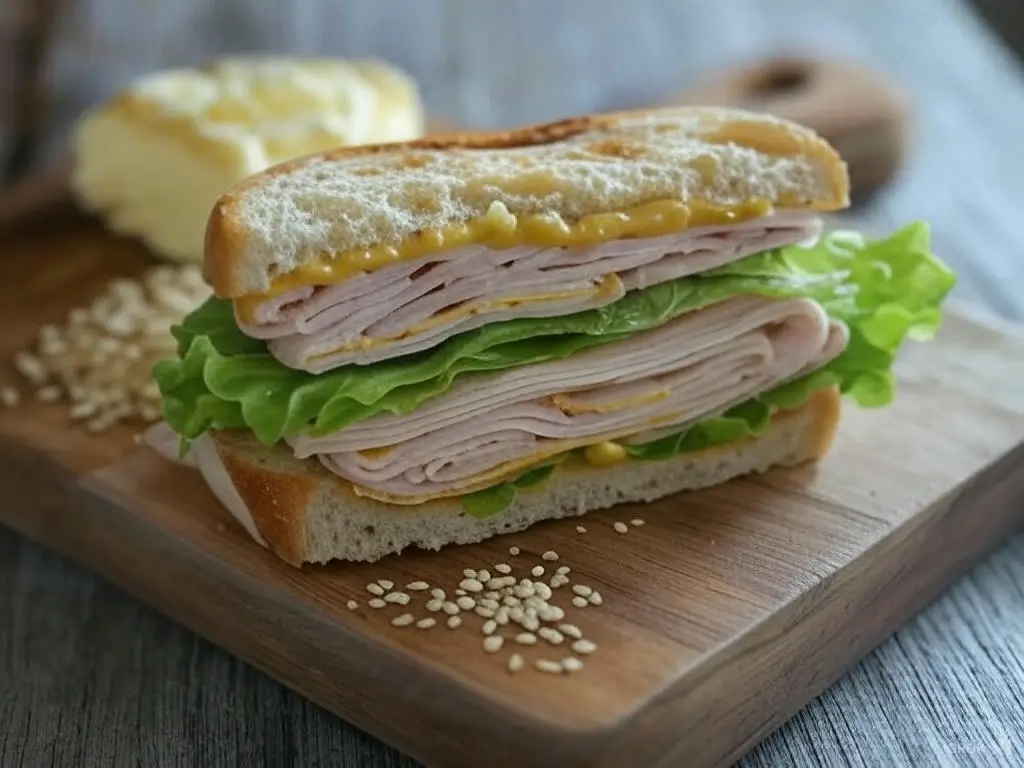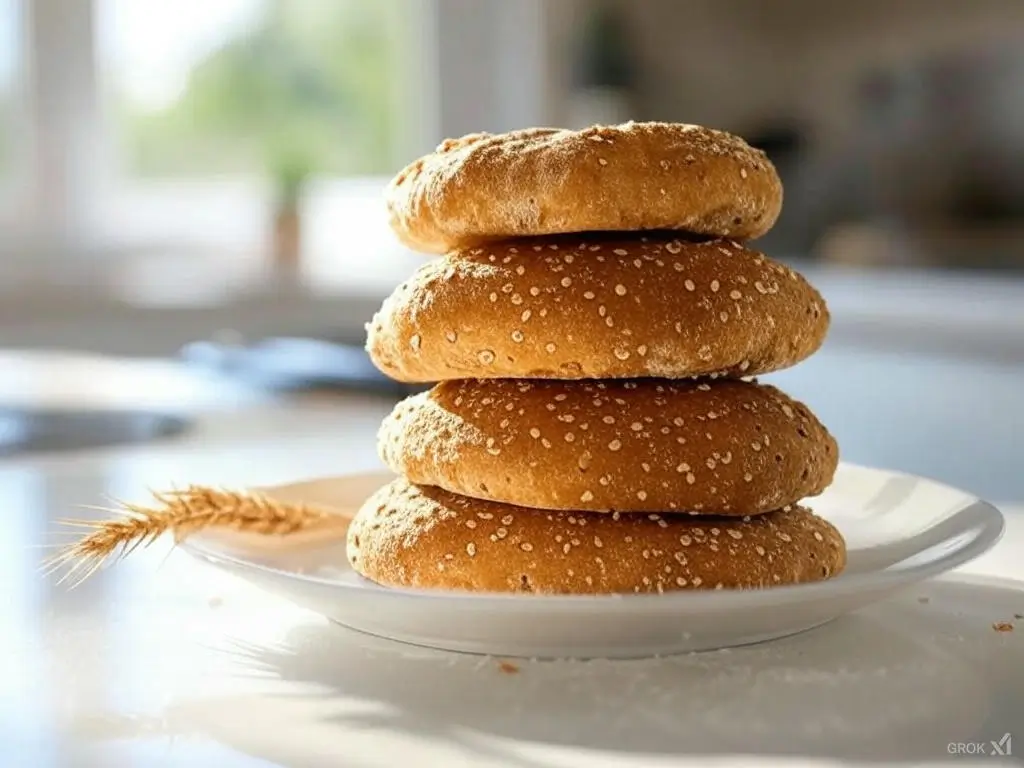Ever bitten into a crusty Kaiser roll and wondered, “How many calories am I chowing down here?” Well, you’re not alone! Whether you’re a bread lover, a calorie counter, or just someone who enjoys a good sandwich, understanding Kaiser roll calories can be a game-changer. In this article, we’re peeling back the layers—think of it like unwrapping a fresh roll—to explore its nutritional nitty-gritty, how it stacks up against other breads, and sneaky ways toppings jack up the count. From its historical roots to diet-friendly tweaks, we’ve got a lot to chew on. Ready to dig in? Let’s roll!
What Are Kaiser Rolls and Their Caloric Basics
Defining the Kaiser Roll: A Bread with History
Oh, the Kaiser roll—it’s not just bread; it’s a legend with a crown-like crust! Born in Austria centuries ago, this beauty’s got a rich backstory tied to emperors (yep, “Kaiser” means emperor). Traditionally, bakers stamped it with a swirl to mimic a royal seal, and honestly, it still feels a bit fancy. But beyond the pomp and circumstance, it’s a staple at delis and breakfast tables. Made with simple stuff—flour, water, yeast, and a pinch of salt—it’s the texture that hooks you: crispy outside, soft inside. So, before we crunch the numbers on Kaiser roll calories, let’s appreciate what makes this roll royalty.
Dive into our complete Kaiser roll guide to master this classic bread.
Origins of the Kaiser Roll
Picture this: 18th-century Vienna, bakers whipping up rolls to impress the Habsburgs. That’s where the Kaiser roll strutted onto the scene. Some say it was a tribute to Emperor Franz Joseph; others argue it’s just a darn good marketing gimmick. Either way, its nutritional value hasn’t changed much—simple ingredients, straightforward vibes. Knowing its roots adds flavor to every bite, doesn’t it?
What Makes a Kaiser Roll Unique?
It’s all about that crusty top and airy middle! Unlike your average squishy bun, Kaiser rolls get their signature look from a special folding trick or a stamp before baking. Plus, they’re often dusted with poppy or sesame seeds, tweaking the Kaiser roll calories a smidge. That combo of crunch and fluff? It’s why folks can’t resist ’em for sandwiches or solo snacking.
Kaiser Roll Calories at a Glance
Alright, let’s get to the good stuff—how many calories are we talking? On average, a standard Kaiser roll (about 2-3 ounces) clocks in at 150-200 calories. Not bad for a bread that’s basically a hug in food form, right? But hold on, that’s just the baseline. Size, ingredients, and extras can shift the tally, so let’s break it down.
Average Calorie Count in a Standard Kaiser Roll
For a typical store-bought version, you’re looking at 150 calories for a 2-ounce roll. Homemade ones might nudge closer to 180, depending on the recipe. Nothing wild, but enough to keep an eye on if you’re tracking calories in a Kaiser roll for your daily grind. Simple, satisfying, and—dare I say—pretty reasonable!
How Size Affects Kaiser Roll Calories
Here’s the kicker: size matters! A petite 1.5-ounce roll might drop to 120 calories, while a hefty 4-ounce deli monster could hit 250. More dough, more carbs, more calories—it’s basic math. So, next time you grab one, weigh your options (literally) to keep those Kaiser roll calories in check.
Nutritional Breakdown of Kaiser Roll Calories
What’s Inside a Kaiser Roll?

So, you’re eyeing that Kaiser roll, wondering what’s fueling those Kaiser roll calories. Well, it’s not just fluffy goodness—there’s a nutritional story here! At its core, this bread is a mix of flour, water, yeast, and salt, but the details matter. Let’s slice it open and see what’s really going on inside, from carbs to a dab of protein. Trust me, knowing this can change how you enjoy your next bite!
Carbohydrates and Kaiser Roll Calories
First off, carbs are the big players here. In a standard 2-ounce roll, you’re looking at about 30-35 grams of carbohydrates—yep, that’s where most of those 150-200 calories come from. They’re quick energy, sure, but they can pile up if you’re not careful. Basically, the flour’s the star, and it’s why Kaiser rolls feel so satisfying yet sneaky on the waistline.
Protein Content in Kaiser Rolls
Now, don’t expect a protein punch. A typical Kaiser roll offers just 4-6 grams, thanks to the wheat flour. It’s not a muscle-builder, but it’s enough to keep you ticking. Still, compared to Kaiser roll calories, protein’s more of a sidekick—not the main event. Pair it with a meaty filling, though, and you’ve got a balanced bite!
Fat and Its Role in Kaiser Roll Calories
Here’s the good news: fat’s barely crashing this party. With less than 1-2 grams per roll, it’s not adding much to the caloric density. Sometimes, a baker might brush it with oil for that glossy crust, nudging the count up a tad. But generally? Kaiser rolls keep it lean, letting carbs take the spotlight.
Comparing Homemade vs. Store-Bought Kaiser Roll Calories
Alright, here’s where it gets fun—does making your own Kaiser roll shift the calorie game? Spoiler: it can! Whether you’re kneading dough at home or grabbing a pack from the store, Kaiser roll calories vary a bit. Let’s break down why that happens and what it means for your plate.
Caloric Differences in Preparation Methods
Homemade rolls might hit 180 calories, especially if you’re generous with the flour or add a butter wash. Store-bought ones, though, often stick to 150, thanks to precise recipes. However, mass production can mean less love and more stabilizers—small trade-offs for those calories in a Kaiser roll.
Impact of Ingredients on Kaiser Roll Calories
Ingredients are the real game-changer. Toss in whole wheat flour at home, and you might tweak the nutritional value (and calories). Store versions might sneak in sugar or additives, bumping up the count slightly. Either way, it’s your call—control the dough, control the calories!
Factors Influencing Kaiser Roll Calories

How Toppings and Fillings Boost Kaiser Roll Calories
Okay, a plain Kaiser roll’s one thing, but who eats it naked? Toppings and fillings can turn Kaiser roll calories into a whole different beast! Whether you’re slathering on butter or piling it high with deli meats, those extras add up fast. Let’s dig into how your favorite add-ons tweak the tally.
Butter and Spreads: Caloric Add-Ons
Smear a tablespoon of butter—bam, you’ve tacked on 100 calories. Cream cheese? Another 50-70, depending on how thick you go. Suddenly, your 150-calorie roll is flirting with 250. It’s delicious, sure, but those spreads can make Kaiser roll sandwich calories a sneaky splurge.
Sandwich Fillings and Their Caloric Impact
Now, let’s talk sandwiches. Add a slice of cheese (80 calories), some ham (60 calories), and mayo (90 calories), and your Kaiser roll’s pushing 400 calories total. Tasty? You bet. But if you’re watching calories in a Kaiser roll, lighter fillings like turkey or veggies might save the day.
Kaiser Roll Variations and Their Calorie Counts
Not all Kaiser rolls are created equal—some come with twists that shake up the Kaiser roll calories. Whole wheat, seeds, you name it—each tweak brings a new vibe to the bread basket. Curious? Let’s check out how these variations stack up.
Whole Wheat Kaiser Roll Calories
Going whole wheat sounds healthy, right? It can be! A 2-ounce whole wheat Kaiser roll might hover around 160-180 calories, with extra fiber to boot. Sure, it’s a smidge higher than white, but that nutty flavor and staying power? Totally worth it for some folks.
Seeded Kaiser Rolls: A Caloric Twist
Poppy or sesame seeds sprinkle on more than crunch—they nudge calories up too. A seeded roll might jump to 170-200 calories, thanks to those tiny fat bombs. Still, the boost is small, and the texture’s a win if you’re into that extra zing.
Explore substitutes for chocolate in ganache for lighter dessert pairings with Kaiser rolls.
Baking Techniques That Alter Kaiser Roll Calories
Believe it or not, how a Kaiser roll’s baked can tip the scales. Oil, steam, or even cooking time—little tricks change more than just the crust. So, let’s peek behind the oven door and see how bakers play with Kaiser roll calories.
Oil vs. No-Oil Baking Methods
Brushing dough with oil before baking adds shine—and about 10-20 calories. Skip it, and you’re leaner at 150 or so. Honestly, it’s a small tweak, but for calorie hawks, every bit counts when tallying Kaiser bun calories.
How Cooking Time Changes Caloric Density
Overbake a roll, and it dries out, shrinking slightly—fewer calories by weight. Undercook it, and it’s denser, holding more energy content. The difference? Maybe 5-15 calories. Not huge, but it’s a fun fact to toss around at your next bread debate!
Kaiser Roll Calories in Popular Diets
Kaiser Roll Calories in a Low-Carb Diet
So, you’re on a low-carb kick, eyeing that Kaiser roll like it’s a forbidden treasure. Can it fit? Well, Kaiser roll calories clock in at 150-200, but the carbs—around 30-35 grams—are the real hurdle. For strict plans like keto, that’s a tough sell. Still, let’s explore how it stacks up and if there’s a workaround for bread lovers dodging carbs.
Can Kaiser Rolls Fit a Keto Plan?
Honestly, keto’s brutal—think 20-50 grams of carbs a day tops. A single Kaiser roll nearly blows that budget! Sure, the energy content isn’t sky-high, but those carbs make it a no-go for most keto folks. Unless you’re splitting it into tiny bites over days (who does that?), it’s probably off the menu.
Alternatives to Lower Kaiser Roll Calories
But wait—there’s hope! Swap in a whole wheat version for extra fiber, or hunt down low-carb recipes online. Some clever bakers use almond flour or psyllium husk, slashing carbs to 5-10 grams and keeping calories around 120. Not quite the classic, but it’s a tasty way to keep Kaiser vibes in your diet impact.
Kaiser Rolls and Calorie Counting for Weight Loss
Now, if you’re just counting calories—not carbs—Kaiser rolls can totally play ball. At 150-200 calories, they’re manageable if you plan smart. After all, weight loss is about balance, not bans. So, let’s figure out how to enjoy them without tipping the scale.
Portion Control Tips for Kaiser Roll Calories
First off, size it down—a 1.5-ounce roll trims things to 120 calories. Or, scoop out the middle for a lighter bite (bonus: more room for fillings!). Pair it with a salad, and you’re golden. Basically, it’s all about keeping Kaiser roll calories in check while still savoring that crusty goodness.
Pairing Kaiser Rolls with Low-Calorie Foods
Here’s the trick: load up on low-cal pals. Think turkey (30 calories a slice), mustard (negligible), and a pile of veggies. Suddenly, your Kaiser roll sandwich calories stay under 300, leaving room for the day. It’s like giving your roll a healthy posse—tasty and guilt-free!
How Kaiser Roll Calories Stack Up Against Other Breads

Kaiser Roll Calories vs. White Bread
Alright, let’s pit Kaiser rolls against the bread aisle’s golden child: white bread. Both are classics, but how do their calories compare? Spoiler: Kaiser rolls hold their own! With 150-200 calories for a 2-ounce roll, they’re in the same ballpark as white bread. But there’s more to this showdown.
Caloric Comparison by Weight
A 2-ounce slice of white bread—say, two sandwich slices—runs about 140-160 calories. Kaiser rolls edge up slightly at 150-200, thanks to their denser crumb. Still, the difference is tiny, so it’s more about texture than a calorie crisis. Pick what vibes with your meal!
Nutritional Differences Beyond Calories
Beyond Kaiser roll calories, white bread’s often softer and sweeter, with less fiber—maybe 1 gram vs. a Kaiser’s 2. Kaiser rolls also skip the heavy sugar some white loaves sneak in. So, while calories are close, the Kaiser might nudge ahead for a slightly heartier bite.
Check Alpha Baking’s 3.25″ Dinner Kaiser Roll for a fresh take on this classic bread.
Kaiser Roll Calories vs. Other Rolls (Bagels, Brioche)
Now, let’s widen the ring—how do Kaiser rolls fare against bagels and brioche? These rolls all bring their A-game, but their caloric profiles? Oh, they vary big time. Let’s break it down and see where our Kaiser lands.
Bagel Calories Compared to Kaiser Rolls
Bagels are hefty—a 3-ounce one slams you with 250-300 calories. Compare that to Kaiser bun calories at 150-200 for 2 ounces, and it’s no contest. Bagels pack more dough and chew, so if you’re calorie-conscious, the Kaiser’s your lighter champ.
Brioche Rolls: A Richer Caloric Profile
Then there’s brioche—soft, buttery, and a calorie bomb. A 2-ounce brioche roll can hit 200-250 calories, thanks to eggs and fat. Kaiser rolls, with their leaner nutritional value, stay simpler and lower. Craving richness? Brioche wins. Watching the scale? Stick with the Kaiser.
Discover the delightful world of banana bread cookies for a sweet bread alternative.
FAQs About Kaiser Roll Calories
Got questions about Kaiser roll calories? You’re not alone! People are buzzing about this crusty roll—how many calories it packs, how it compares, and if it’s diet-friendly. So, let’s tackle the top queries straight from the “People Also Ask” crowd and beyond. Ready for some quick, tasty answers? Here we go!
How Many Calories Are in a Plain Kaiser Roll?
First up, the big one: a plain, 2-ounce Kaiser roll typically lands at 150-200 calories. Simple, right? But size matters—a smaller 1.5-ounce roll might dip to 120, while a hefty 3-ounce one could nudge 250. So, check your roll before you chow down!
Are Kaiser Rolls High in Calories Compared to Other Breads?
Not really! Compared to a 250-calorie bagel or a 200-calorie brioche, Kaiser roll calories are pretty tame. Sure, they’re a tad higher than white bread’s 140-160, but the difference is small. Honestly, it’s more about what you slap on top than the roll itself.
Can I Reduce Kaiser Roll Calories Without Losing Flavor?
You bet! Scoop out the soft middle to drop 20-30 calories, or go for a whole wheat version with extra fiber—still tasty at 160-180. Even better, skip the butter and pile on veggies. Flavor stays, calories shrink—win-win!
What’s the Calorie Count of a Kaiser Roll Sandwich?
This depends on your fixings. Start with 150 calories for the roll, add 100 for butter, 80 for cheese, and 60 for ham—boom, you’re at 390. Lighten it with turkey and mustard, and you’re closer to 250. Your sandwich, your rules!
Are Kaiser Rolls Healthy for Daily Eating?
In moderation, sure! They’ve got decent nutritional value—2 grams of fiber, low fat—but those 30 grams of carbs can add up. Pair them with protein and greens, and they’re a solid pick. Just don’t make them your every-meal MVP!
Explore detailed Kaiser roll nutrition facts to see how calories in a Kaiser roll break down.
Conclusion
Kaiser roll calories might feel like a tiny piece of the puzzle, but they can shift your whole eating game—whether you’re savoring a loaded sandwich or keeping tabs on every nibble. Rooted in history, these rolls deliver a flexible bite with a modest 150-200 calories for a standard size. Once you get how toppings, baking tricks, and tweaks like whole wheat play into the count, enjoying them guilt-free becomes a breeze. So, next time you snag a Kaiser roll, you’ll know its secrets—and how to fit that crusty goodness into your day without a hitch!
Learn why baking powder skips banana bread and how it differs from Kaiser rolls.
Try this banana bread cookies recipe for a twist on traditional bread calories.
Find out if daily sourdough bread is okay compared to calories in a Kaiser roll.
Check if sourdough bread suits IBS versus Kaiser roll nutrition.





